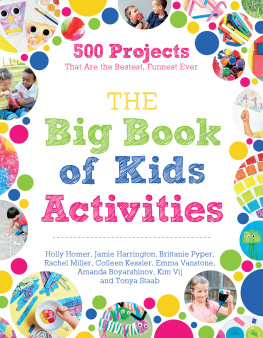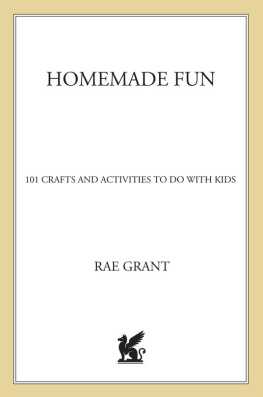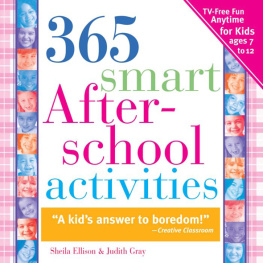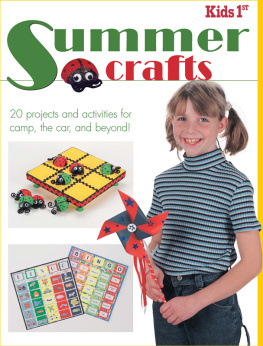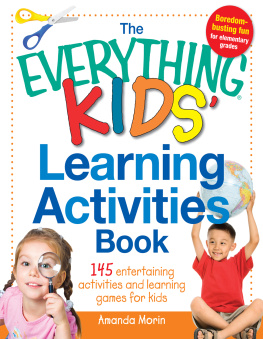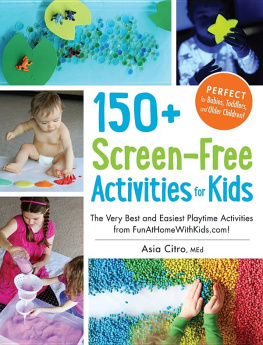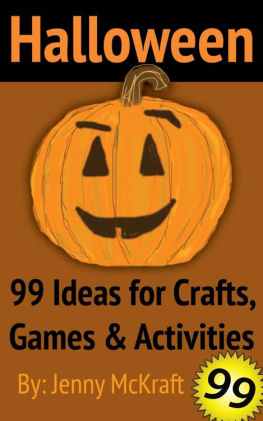Contents
Guide
500 Projects
That Are the Bestest, Funnest Ever
THE
Big Book
of Kids
Activities
Holly Homer, Jamie Harrington, Brittanie Pyper, Rachel Miller, Colleen Kessler, Emma Vanstone, Amanda Boyarshinov, Kim Vij and Tonya Staab

The author and publisher have provided this e-book to you for your personal use only. You may not make this e-book publicly available in any way. Copyright infringement is against the law. If you believe the copy of this e-book you are reading infringes on the authors copyright, please notify the publisher at: http://us.macmillanusa.com/piracy.
The thing about kids is they grow up. They start out inquisitive, adventurous and wildly participatory. They find thrill in activities, silly games and simple crafts. Somewhere along the way a governor gets placed that says that inquiry can only be serious, adventures should be within a specific path and participation needs a leader.
Why is play constrained?
Why do adults look both ways before joining in?
Why isnt play the first thing on the family calendar?
Modern life has filled our schedules with things that we have to do. Modern life has filled our schedules with things our kids have to do. Modern life has held us captive indoors.
We want to play.
We long for time together.
We seek fun.
The good news is that play is waiting on us. It sits quietly giggling at the dining room table, under the bed, behind the curtains, in the kitchen junk drawer, in the trunk of the car, between the couch cushions and peeking through the door to the backyard.
Play doesnt mind if you stop by for just a moment. It is fine with being added to the situation at the last minute. It loves occupying those little moments between the scheduled ones and then sneaking into the rest of the day.
Play can take an ordinary day and make it a favorite day. It doesnt require equipment, money or planning. It can fill a moment. It can fill a day. And when intentionally sought out, it can fill a life.
We want to value time over toys. We want our kids to keep play close as they grow and weave it into their future. We want them to remember the times we played together.
Our fondest memories of childhood are those filled with play. Our bedrooms werent filled with toys, they were chock-full of possibilities. Our play wasnt fancy or structured, it followed us around like an imaginary friend.
There were homemade wooden blocks in the living room and a rag doll on the bed. There were woods to explore and sketches of tree house plans waiting to be built. There were fireflies in a jar on the bedside table and a mysterious cocoon taped upright to the bookshelf. We had collections of rocks and a stack of homemade games created with items from the kitchen junk drawer. There was a garden outside that attracted sneaky rabbits and a swing whose arc was never-ending. There were diaries that held novels in progress and frozen containers of yogurt to eat on the back porch. There were distant travels on a magical throw rug and craft projects that required broken crayons and scraps of yarn. There were orchards that smelled like cider and snow that was shoveled into games of fox and hound. Stairs doubled as slides and bicycles rode faster than the wind. There were books to read and reread and blanket tents large enough for a revival. There were plays to write, act and direct with an audience of stuffed animals and card games that ended in playful boasts. There were endless trees to climb and imaginary friends to visit.
We hope that this book inspires you to find play in big and small moments every day. We hope it is an imagination boost that launches childhood memories beyond these pages.
We believe that you dont need the latest gadgets or an elaborate plan to engage children. Play meets everyone right where they are with what they have in their hand.
Sure, play is fun, but children will learn life skills that will stay with them forever. Finding joy, acting with diligence, teamwork, gratitude, mindfulness of others, patience, compassion, sportsmanship and respect are all play companions.
Play is family glue.
Lets play!
Unless otherwise specified, each of these activities may be enjoyed by one or more participants. Often, our activities include optional modifications to take the age of the kid(s) into greater consideration. The suggested Modifications for Younger Kids are more suitable for ages one to three; those for older kids are more suitable for ages four to ten. And of course, many of these activities are truly for kids of all ages, so feel free to join in the fun!
Making something with a child is about the process, not the product. The memories are made from the collective energy of creation. The finished craft is an experience souvenir.
Hollys Pick: I adore the because over time, markers become very dear to me and this is a way to use them all the way up!
Rachels Pick: is a great way for kids to be active while creating art! The finished product looks a bit like Pollocks works. We have several on our walls.
Bubbles and childhood are a perfect match. They require a surprising amount of concentration to create. The perfect bubble is one that is a bit bigger or elongated or has a particularly bright rainbow or holds together longer. Actually, the perfect bubble seems to be the current one!
This activity uses bubbles to create art prints. It includes our favorite bubble recipe and a fun use of recycled water bottles to create a bubble rainbow.
Materials
(to make one bubble shooter)
+ 9 to 12 drinking straws
+ Rubber band
+ Broad plastic cup
+ Multiple sheets of paper
Strongest Bubbles
(to make about 1 cups [360 ml] bubble solution)
+ 1 cup (235 ml) water
+ cup (80 ml) liquid dish detergent (not concentrated; if concentrated, use slightly less)
+ 3 tbsp (45 ml) corn syrup
+ 10 to 15 drops food coloring
It is best to stir the ingredients to mix them, not shake. Let it sit overnight for the best results. We split our recipe into multiple baby food jars and then added food dye for our printing craft.
Grab a handful of straws and secure them together with a rubber band. We found that five or six straws worked best.
Dip one end into the bubble solution placed into a plastic cup broad enough to accommodate the straw bundle. Blow lots of bubbles!
Hold the end of the shooter over a piece of paper and see what happens on the paper as the colored bubbles pop. Let dry.
Modifications for Younger Kids
Instead of using dish detergent to create the bubbles, make them pain-free by using tear-free baby wash. This way, if your child gets a bubble in an eye it wont sting.
Younger kids who might inhale with the straw in their mouth vs. exhale should continue to use a bubble wand until the coordination is mastered. No one wants a mouthful of bubbles!
Modifications for Older Kids
Cut the bottom off a water bottle. Put a dish rag over the opening and use a rubber band to secure that to the bottle. Dip the rag into the bubble juice and blow on the mouth of the bottle. The result should be a snake of bubbles.

